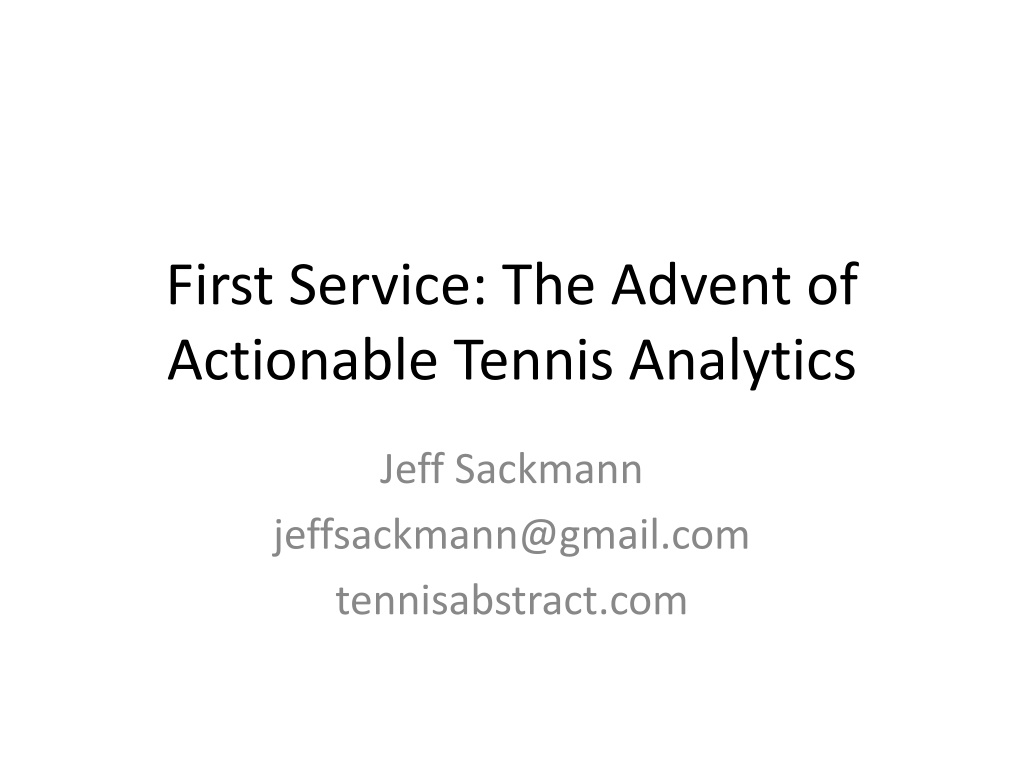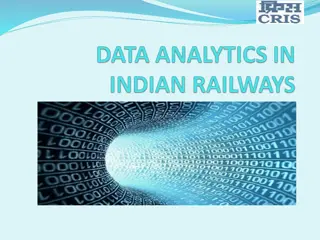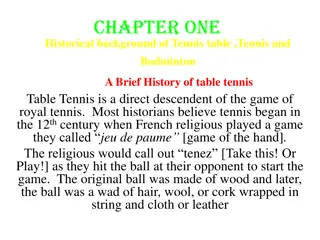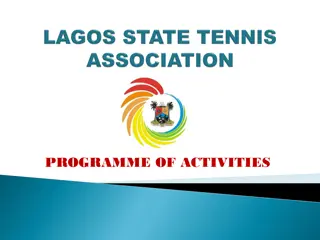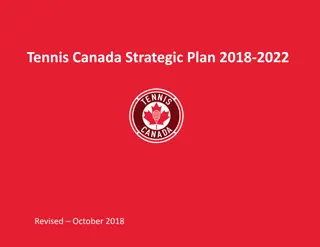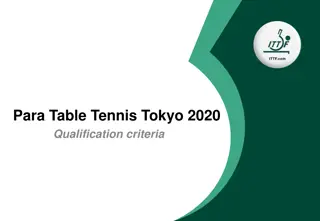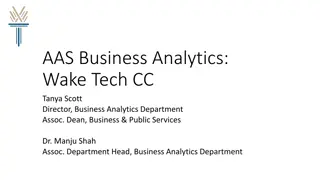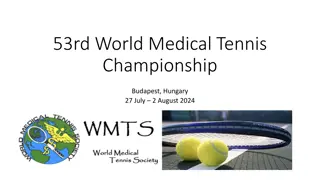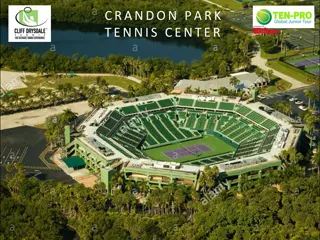The Advent of Actionable Tennis Analytics
Discover the challenges and opportunities in tennis data analytics, exploring the current state of available data sources, the lack of engagement in the tennis world, and the potential for schedule optimization. Jeff Sackmann delves into how existing analytics have been tailored for bettors rather than players and proposes solutions to enhance the use of data in tennis.
Download Presentation

Please find below an Image/Link to download the presentation.
The content on the website is provided AS IS for your information and personal use only. It may not be sold, licensed, or shared on other websites without obtaining consent from the author.If you encounter any issues during the download, it is possible that the publisher has removed the file from their server.
You are allowed to download the files provided on this website for personal or commercial use, subject to the condition that they are used lawfully. All files are the property of their respective owners.
The content on the website is provided AS IS for your information and personal use only. It may not be sold, licensed, or shared on other websites without obtaining consent from the author.
E N D
Presentation Transcript
First Service: The Advent of Actionable Tennis Analytics Jeff Sackmann jeffsackmann@gmail.com tennisabstract.com
First Service: Outline 1. The sorry state of tennis data 2. The potential of schedule optimization 3. The Match Charting Project
1. The Sorry State of Tennis Data Too many cooks in the kitchen and no plates.
Whats out there? MatchStats Most pro matches, publicly available Umpire Scorecards All pro matches, rarely available IBM Point-by-point Most Grand Slam matches, sort of available Hawkeye Some top-tier matches, not available
Complete List of Public APIs Offered by Tennis Tours, Tournaments and Federations:
Why So Little Engagement? The tennis world is fragmented. Organizations have treated analytics as something to be sponsored (if they consider it at all). Individual sports don t tend to reward use of analytics the way team sports do. It s easy to measure each player s contribution. Existing analytics (and data sources) have developed for bettors, not players.
Enough whining already What can we do with what we have?
2. The Potential of Schedule Optimization The stakes are high.
Not All Events Are Created Equal The biggest events on the ATP and WTA tours are mandatory for players who qualify. Still, every player has some leeway in determining their schedule. Second-tier players (ranked between #50 and #200) have a huge amount to gain here.
WTA Case Study: DC vs Stanford Two events played in the same week, in the same country, on the same surface. Most players who competed in either event could have entered the other. Stanford (Premier) Winner gets 470 ranking points and $120,000 Washington (International) Winner gets 280 ranking points and $43,000
DC vs Stanford: Lucie Safarova Ranked #17 in the world Would be top seed and title favorite in DC Would be #8 seed in Stanford, could face Serena or Radwanska as early as quarterfinals.
DC vs Stanford: Lucie Safarova (2) Washington: 14% chance of winning the title. Stanford: 3% chance of winning the title. Which would you choose?
DC vs Stanford: Lucie Safarova (3) Washington Expected points: 87 Exp prize: $11,800 Stanford Expected points: 95 Exp prize: $21,170
What happened? First round loss to Kiki Mladenovic: - Ranking points: 1 - Prize money: $2,220
DC vs Stanford: The Big Picture Of 48 direct entrants, 48 would be expected to earn more prize money in Stanford. Of the 48, 37 would be expected to earn more ranking points in Stanford. Most of the exceptions were players who would be seeded in DC, but not in Stanford. Ekaterina Makarova: #2 seed in DC. Would be expected to earn 15% more points in DC.
The Even Bigger Picture Seeds matter. (Duh.) If you ll be seeded at one event but not at the other, go where you ll be seeded. (Unless prize money is more important than ranking points. We ll come back to that.) If you ll be seeded at both or unseeded at both, go where the rewards are greater.
Ranking Points > Prize Money (Except when paying travel expenses.) Short-term prize money might be necessary, but Short-term points more seeds long-term points and prize money
Seeds Really Matter Belinda Bencic: #32 seed in Melbourne Madison Keys Ranked #33 unseeded
Seeds Really Matter (2) Keys got a lucky draw (and played well) but Before the draw was made: Bencic: 46% chance of reaching third round Keys: 29% chance of reaching third round More money and more ranking points all because of the seed!
Two Wrinkles (of Many) 1. Byes In comparing a similar pair of ATP events, some players who chose the tourney with more points/money would ve been better off at the smaller event because of a first-round bye. 2. Unknowns in the draw
Predicting the Future is Hard Analyzing player choices from 2013 Bucharest (250 points) and Barcelona (500 points and four times the money), many chose wrong But if Nadal hadn t played, their choice would ve been optimal. (That said, Nadal on clay is the exception that breaks every model.)
Additional Considerations Many reasons why players might make an apparently suboptimal choice: Sponsor commitments Appearance fees Past success at the event Desire for more match play Prioritizing their doubles schedule
Weve determined where to play What can we say about how to play?
3. The Match Charting Project Hawkeye data for dummies.
The Problem Hawkeye data is amazing. Independent researchers have no (or very limited) access to it. If we had it, we could do so much of value. Whining about it doesn t help. (I ve tried. You ve heard me.) We re not going to get it anytime soon.
Solution: Crowdsourced Charting Lots of fans watch lots of tennis. Lots of fans want better tennis stats. (At least they say they do.) A fan and a spreadsheet can t replicate Hawkeye cameras, but they can track an awful lot of things, much of it in real time.
Match Charting Project basics Here s what the spreadsheet looks like:
MCP: What Were Tracking Every serve: Direction, type of error, s-and-v approach Every return: Type of shot, direction, depth Every shot: Type of shot, direction, approach, court position Every point: Ending (winner, forced/unforced error, etc.)
MCP: Coverage So Far One year in: 667 matches 400+ different players 10+ matches for 29 different players 60+ matches for Federer, Nadal, and Halep 30+ contributors (Did I mention 60+ Halep matches? Just a sec )
MCP: Sample Output Djokovic return breakdown, 2014 French Open final:
MCP: Sample Output (2) Easy comparison with tour and player averages, overall and by surface:
MCP: Sample Output (3) Success and frequency of every type of shot for Rafael Nadal (2014 French Open final):
MCP: Sample Output (4) Full text shot-by-shot:
Player Tendencies: A Sample Take, for example, 1stserves in the ad court. (limiting our view to matches between RHs) Wide and T serves are more effective than serves in the middle of the box (big surprise): Wide serves: 72.6% of returns put in play Body serves: 83.9% of returns put in play T serves: 71.1% of returns put in play Same trend with point results (34%/43%/34%)
but not against Simona Simona Halep: Same distribution of returns in play (77%/86%/78%) End result is very different! (39%/47%/46%) She neutralizes the T serve weapon (She did win that point)
Digging Deeper: Rally Tactics Still keeping things simple, categorize all shots by: In which third of the court they were hit Which type of shot To which third of the court they were hit Example: Corner-to-corner (crosscourt) FH This gives us 18 permutations: 12 common
Crosscourt Forehand Responses Crosscourt Up the Middle Down the Line Point Win% AVERAGE 37.7% 28.8% 33.6% 66.4% Azarenka 30.3% 25.9% 43.8% 56.2% Halep 35.6% 30.9% 33.5% 66.5% Radwanska 37.5% 28.4% 34.1% 65.9% Sharapova 34.6% 24.8% 40.6% 59.4% S. Williams 39.5% 32.2% 28.3% 71.7% Wozniacki 36.2% 24.3% 39.5% 60.5%
Not Digging Too Deep That table represents outcomes of just one of twelve common groundstroke permutations. (Ignoring slices, approach shots, all net play ) Having a tour-wide dataset is so important: The differences between players are minor Even experts can t look at these numbers without context and have a clue what they re seeing
but Deep Enough Even simplifying the court to three sectors, generally ignoring shot depth, and failing to track speed, there s a wealth of actionable data here. It s a heck of a lot cheaper than Hawkeye.
You Can Help! (And You Should) It s easy to find The Match Charting Project (and the hundreds of detailed match reports) via my sites: tennisabstract.com heavytopspin.com You ll start watching tennis really intently!
Thanks! Jeff Sackmann jeffsackmann@gmail.com tennisabstract.com
